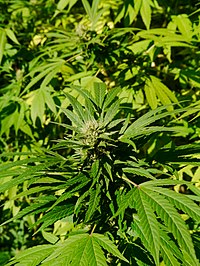
Photo from wikipedia
Shade management (dark treatment) on tea (Camellia sinensis) plants is a common approach to improve free amino acids in raw materials of tea leaves. However, the reason for amino acid… Click to show full abstract
Shade management (dark treatment) on tea (Camellia sinensis) plants is a common approach to improve free amino acids in raw materials of tea leaves. However, the reason for amino acid accumulation in dark-treated tea leaves is still unknown. In the present study, dark treatment significantly increased content of free amino acids and reduced content of soluble proteins in tea leaves. Quantitative proteomics analysis showed that most enzymes involved in biosyntheses of amino acids were down-accumulated by dark treatment. Chloroplast numbers reduced in dark-treated leaves and the content of soluble proteins reduced in the chloroplasts isolated from dark-treated leaves compared to control. These suggest that proteolysis of chloroplast proteins contributed to amino acid accumulation in dark-treated leaves. Two chloroplasts proteases, ATP-dependent Clp protease proteolytic subunit 3 and protease Do-like 2, were up-accumulated in dark-treated leaves. This study firstly elucidated the mechanism of accumulation of amino acids in dark-treated tea leaves. BIOLOGICAL SIGNIFICANCE Effect of dark on crop growth has been widely studied, while less attention has been paid to effect of dark on quality-related metabolites in crops. Shade management (dark treatment) on tea plants is a common approach to improve free amino acids in tea leaves. However, the reason for accumulation of free amino acids in dark-treated tea leaves is still unknown. In the present study, an iTRAQ-based quantitative proteomic analysis was performed and the results revealed the accumulation of free amino acids in dark-treated tea leaves was not due to activation of biosyntheses of amino acids, but resulted from proteolysis of chloroplast proteins. The information will advance our understanding of formation of quality or function-related metabolites in agricultural crops exposed to dark stress/shade management.
Journal Title: Journal of proteomics
Year Published: 2017
Link to full text (if available)
Share on Social Media: Sign Up to like & get
recommendations!